The concept of pest
by Eric Grissell
| 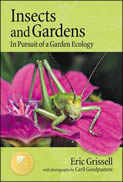
| The concept of pest is entirely a human notion. There are no pests in nature. For humans, pests get to be pests when they teeter out of balance with their environment and do things we don't want them to do ...
Gardeners tend to be fairly level-headed folks, but when insects threaten, the garden gloves come off and the boxing gloves go on. It is a gut reaction ...
When these sorts of insects come to call, as often as not the gardener will first seek out the quick cure (whether mechanical or chemical) without thinking too much about the consequences of the action. This is a self-taught, cultural response, which is basically out of sync with the way a garden ought to work and all of nature, in fact, tries to work ...
Unfortunately, when we haul out the pesticides we not only must face the battle, we usually end up prolonging the war we meant to end.
~ Eric Grissell
Insects and Gardens: In Pursuit of a Garden Ecology pp. 204-5
|
| Interested in Edible Gardening? | 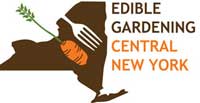
|
If you'd like to get information on Edible Gardening CNY, just send an email to John to find out about edible gardening tours and programs.
|
| Zoo Crew for Habitat Garden upkeep |
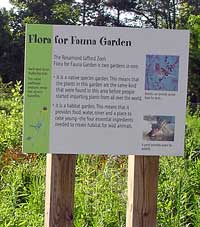 | | Flora for Fauna garden at the zoo |
|
The zoo's habitat
garden has increasingly provided habitat for wildlife over the last few years as the plantings have matured, but unless it's maintained its future is uncertain.
Habitat gardeners to the rescue! Not only is this the ideal service project for habitat gardeners, but it's a wonderful learning opportunity for anyone volunteering. What better way to learn about plants in all stages of growth than to work alongside more knowledgeable gardeners? Soon, you'll be one of those knowledgeable gardeners, too. (And besides contributing service and gaining knowledge, this is also an excellent way to get to know some other people with similar interests.)
Any help is appreciated, but what Flora for Fauna really needs is a core group who can be relied upon to (usually) show up once a week for about 2 hours.
If you're interested, contact Kate Woodle.
|
|
Join HGCNY!
|  |
Becoming an official member of HGCNY is easy: just join Wild Ones! When you're a Wild Ones member, you're automatically an official member of HGCNY. |
|
Greetings!
Time for Show Me, Help Me
Summer is the time for our garden tours, which Wild Ones traditionally calls Show Me, Help Me tours. These aren't the kind of tours where you just admire beautiful gardens. These are tours where you learn from what the host has done and perhaps offer suggestions for any landscaping dilemmas they may have. Some of our tours have expert commentators, too. Our programs during the year are always interesting and informative, but there's nothing like seeing the results in people's yards!
Here are the dates scheduled so far:
Sunday July 17 at 3 pm in Canandaigua
Saturday July 30 in Fulton
Saturday August 27 in Jamesville
Save the dates! We'll have further details about the tours and RSVPs to the hosts in upcoming newsletters. 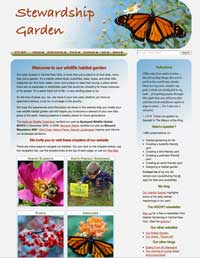 Meanwhile... Meanwhile...You can vicariously tour my own habitat garden by browsing through my website: OurHabitatGarden.org. It's not yet complete or fully edited, but you'll still find lots of information about various creatures and how to provide habitat for them. Janet |
|
|
Let's keep cats inside!
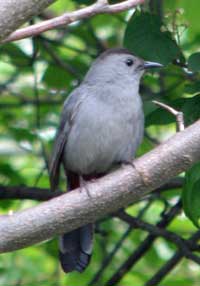 | | Catbird |
The Spring 2011 issue of Bird Conservation, the magazine of the American Bird Conservancy, described a recent study that highlighted the impact of cat predation on young birds.
From the article:
Researchers attached small radio transmitters to 69 newly hatched catbirds. The transmitters tracked the location of the birds every day. Forty-two birds died, 33 of which was due to predation. Half of the known predators were free-roaming cats.
The study found that predation was the most significant factor affecting the young catbirds' survival, and that the vast majority of deaths occurred in the first week after leaving the nest. They're easy prey for cats since they beg loudly for food and aren't yet predator-savvy.
Learn more about cat predation from: American Bird Conservancy Maine Cooperative Extension Tweety was Right - a New York Times article |
|
National Pollinator Week
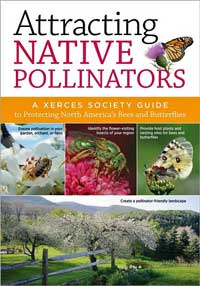 June 20 - June 26 has been designated National Pollinator Week by the Department of Agriculture. What better way to celebrate than by picking up a copy of the new book Attracting Native Pollinators: Protecting North America's Bees and Butterflies by the Xerces Society. June 20 - June 26 has been designated National Pollinator Week by the Department of Agriculture. What better way to celebrate than by picking up a copy of the new book Attracting Native Pollinators: Protecting North America's Bees and Butterflies by the Xerces Society.
The library has a copy of this handy how-to guide or you can buy one to have on hand. It's available from Xerces, Amazon.com, or (probably) at local bookstores.
Reminder: When you buy anything from Amazon.com, if you enter through the Wild Ones online bookstore, Wild Ones gets a percentage of the cost! When you click through to Amazon, everything proceeds as usual, and there is no extra charge to you. Those Really Busy Bees If you don't have time to read a whole book on pollinators, this article from the New England Wildflower Society is a nice summary of how you can help native bees in your own yard. And even if you can do nothing else, as the article says, "just by gardening with native plants, you are increasing the abundance and maybe even the local diversity of our amazing native pollinators -- those really busy bees." |
|
Lawn pesticides
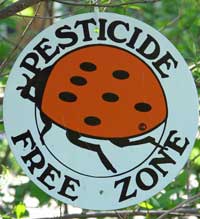 | | This sign can be purchased from the Beyond Pesticides website |
From Beyond Pesticides:
Lawn Fact: During a typical year in neighborhoods across the country, over 102 million pounds of toxic pesticides are applied in pursuit of a perfect lawn and garden. This figure, up from 90 million pounds in the year 2000, continues to grow despite the growing body of scientific evidence of the public health and environmental consequences.
Beyond Pesticides has research-based factsheets about the health and environmental consequences of our lawn pesticides. Here's just a small selection of their factsheets: Some miscellaneous facts from these factsheets: - Biomonitoring testing in Canada finds residues of lawn pesticides, such as 2,4-D and mecoprop, in 15% of children tested, ages three to seven, whose parents had recently applied the lawn chemicals. Breakdown products of organophosphate insecticides are present in 98.7% of children tested.
- Scientific studies show that 2,4-D applied to lawns drifts and is tracked indoors where it settles in dust, air and surfaces and may remain for up to a year in carpets.
They also have a series of factsheets on the same page about Alternatives for Safer Lawn Care. Few research studies can offer conclusive proof since it's difficult to conduct controlled studies in this field, but as Sandra Steingraber says, "Benefit of the doubt goes to children, not to chemicals." |
|
Other ferns
Our last newsletter featured ostrich fern (Matteuccia struthiopteris var. pensylvanica). This fern works well in a location where you want to develop a large patch of ferns. Many other ferns are good in areas where you want to develop a more limited patch.
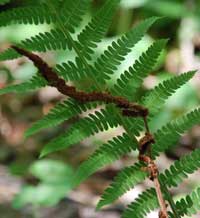 | | Cinnamon fern |
Some of these ferns are:
Interrupted fern (Osmunda claytoniana) - According to William Cullina, "Though it is a tough decision, I would have to say that this is my favorite fern..." He continues, "Interrupted fern fronds are nearly identical to the sterile fronds of O. cinnamomea (cinnamon fern)."
 | | Maidenhair fern |
Maidenhair fern (Adiantum pedatum) - Curving fronds, very refined looking.
|
|
Converting your lawn to garden
Do you want more garden space for some more native habitat plantings or for some edible gardening space? The easiest place to find more space is right under you feet: your lawn.
Sure, you can hand dig the sod, and pile it somewhere, waiting for it to decompose (you certainly wouldn't put this sod/topsoil mix out to the curb!), but this is a lot of work.
Paul Tukey explains how to convert your lawn to garden the easy way by sod-top gardening, and Evelyn Haddon describes a similar approach to smothering your lawn.
Here's the general idea (but check the websites for details):
- mow the grass low to the ground
- cover it with a thick layer of overlapping wet newspapers or cardboard
- add a 4-6 inch layer of manure, compost, or topsoil (Tukey) or 6-10 inches of wood-chip mulch (Hadden)
- plant small plants now by opening up a hole in the newspaper for drainage (Tukey) or dig out a patch a sod through the mulch (Hadden).
Although you can plant right after creating this area, ideally this would be done in the fall so your new garden area is ready for planting in the spring. You can get ready by collecting newspapers and/or cardboard and other materials throughout the summer.
|
|
|
|
|